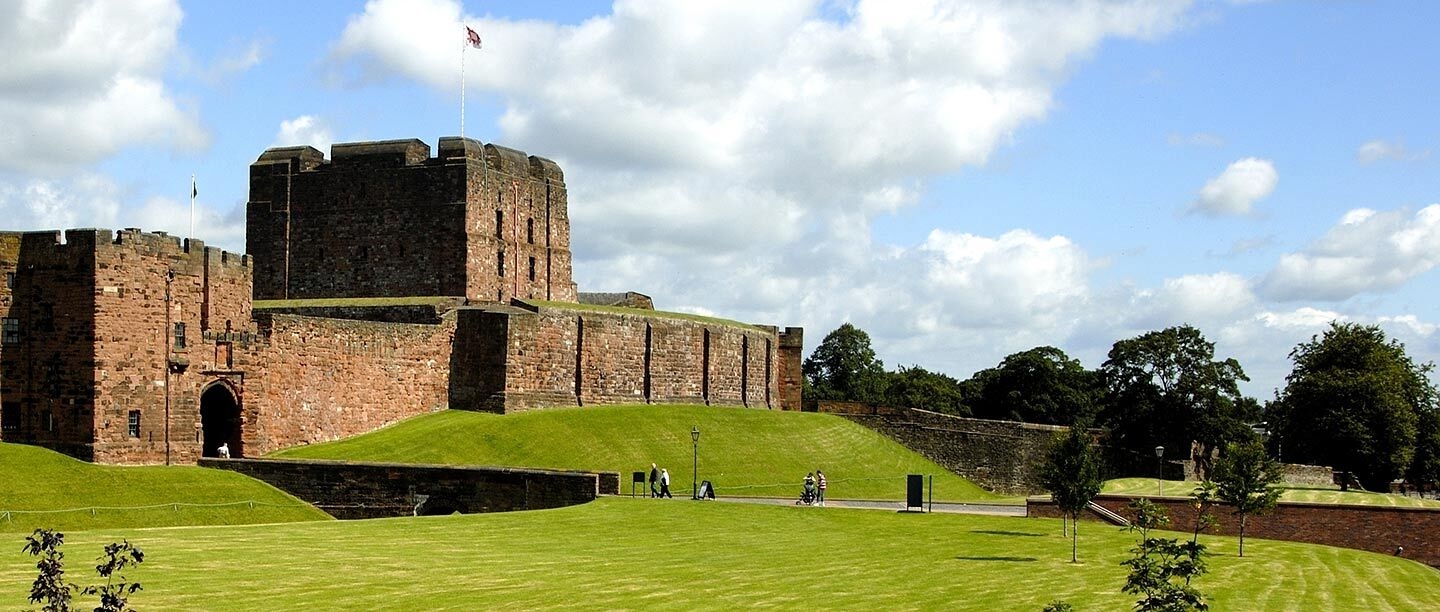Roman Carlisle
In AD 72 a large Roman fort, built of turf and timber, was established on the site of the later castle. It later provided support for garrisons on Hadrian’s Wall and acted as a staging post for troops invading Scotland. The fort became the nucleus of a prosperous town named Luguvalium, which by the mid 2nd century was one of the most important military bases in Roman Britain.[1]
After the end of the Roman occupation of Britain, Carlisle may have been the administrative capital of the Romano-British kingdom of Rheged. An abbey was founded there in the 7th century, possibly by the Kings of Northumbria.
The First Castle
The first castle at Carlisle was built over part of the first Roman fort by William II (‘William Rufus’; reigned 1087–1100) after he defeated the local warlord Dolfin in 1092.
The first castle may have been a ringwork – a simple enclosure of earth and timber, using the natural slope to the north, with a deep ditch cut as a defence to the south. Henry I (r.1100–35) visited Carlisle in 1122 and ordered that it be ‘fortified with a castle and towers’. This may represent the origin of the massive keep,[2] and these works were still in progress in 1130.[3]
After Henry I’s death in 1135, Carlisle was retaken by David I, King of Scotland (r.1124–53), who is said to have built ‘a very strong keep’ there. He may have been completing work begun by Henry I, which leaves the dating of Carlisle’s keep an open question.[4]
Henry II of England (r.1154–89) visited Carlisle in 1186 and made additions that possibly represented the earliest stage of the ‘palace’ complex in the inner ward.[5] In the early 13th century King John (r.1199–1216) may have been responsible for rebuilding the outer curtain wall and the inner ward wall in stone.[6]
Carlisle and the Border
Carlisle’s position on the border between England and Scotland made it a vital stronghold and border defence, and also vulnerable to crises in Anglo-Scots relations.
In 1296 Edward I (r.1272–1307) made Carlisle his headquarters for three months in the early stages of his war against the Scots.[7] The inner ward, which probably already housed a great hall and chamber, was enhanced to accommodate the court. In 1308 a residential tower, later known as Queen Mary’s Tower, was added to provide more fine accommodation.[8]
The Scots besieged the town and castle seven times between 1173 and 1461. One of the most determined sieges was that in 1315 by Robert the Bruce, King of Scotland, following his victory over the English at the Battle of Bannockburn the previous year. The Scots failed to take the castle, however, and they retreated with the loss of only two English lives.[9]
The siege of 1461 was one of the bloodiest episodes of the Wars of the Roses, the struggle for the English throne between the Houses of Lancaster and York. A combined army of Lancastrians and Scots succeeded in taking the castle from the Yorkists through the early use (in a British context) of artillery. Despite this, the castle’s defences remained relatively little altered.
FIND OUT MORE ABOUT ANDREW HARCLAYThe 15th and 16th Centuries
Carlisle played an important part in the turbulent history of the 15th and early 16th centuries, when the rule of law broke down over virtually the whole border region. On both sides, clan and family groups formed into armed bands of ‘reivers’, who regularly robbed and pillaged their neighbours.[10]
In an attempt to manage the problem, the English border region was divided into three ‘marches’, and lord wardens were appointed as the Crown’s chief representatives. Carlisle Castle was the seat of the Lord Warden of the West March. Richard, Duke of Gloucester, later Richard III (r.1483–5), was among the notable figures who filled the role.[11]
After 1538 England’s diplomatic isolation was emphasised by Scotland’s renewed alliance with France. Henry VIII (r.1509–47) ordered a review of Carlisle’s defences.
The result was the largest campaign of building that the castle had seen since the 12th century, directed by a Moravian engineer, Stephan von Haschenperg.[12] These works included the lowering of the keep and the construction of an artillery platform on its roof, the thickening of the inner ward walls, and the building of the half-moon battery.
Famous Prisoners at Carlisle
When Mary, Queen of Scots (d.1587), fled from her rebellious subjects to England in May 1567, she was housed for some weeks in what was then known as the Warden’s Tower, in the south-east corner of the inner ward. This was the last time the castle was used as a royal residence. Supporting her little court there cost Elizabeth I (r.1558–1603) an average of £56 a week in food and wine.[13]
The castle was also used as a prison for border reivers. A famous incident involved the notorious William Armstrong of Kinmont (‘Kinmont Willie’). A large armed group of his friends broke into the castle using ladders and freed him on 13 April 1596.[14]
READ MORE ABOUT MARY QUEEN OF SCOTS’ IMPRISONMENT
Civil War
Carlisle Castle should have become obsolete as a border fortress after the Union of the English and Scots Crowns in 1603. That it did not was due to the bitter opposition in Scotland to the religious policies of Charles I (r.1625–49), which contributed to the outbreak of the Civil War in 1642.
Garrisoned by the Royalists in 1642, Carlisle was one of the few places in the north that held out for the king after the defeat of his main northern army at Marston Moor, in July 1644. In October of that year a Parliamentarian army swiftly surrounded Carlisle with guns and earthworks, and settled down to starve the city out.
In spring 1645 English troops joined them, and their grip on the city became tighter. Food began to run out: all the horses were eaten, then the dogs and rats. After the Royalist defeat at the Battle of Naseby in June 1645, there seemed no more hope of relief, and on 25 June the city surrendered.
READ MORE ABOUT THE ENGLISH CIVIL WARS
Carlisle’s Last Siege
The city and castle returned once more to centre stage during the second Jacobite rising of 1745–6, which attempted to restore the exiled Stuarts to the throne. Prince Charles Edward Stuart (d.1788) led his army south, reaching Carlisle on 9 November 1745. The city and castle surrendered five days later.[15]
The Jacobite army marched south, but finding little support turned around at Derby. On 20 December, it retreated over the border into Scotland, leaving a garrison of 400 in Carlisle Castle to hold off the English pursuit led by the Duke of Cumberland.
The castle then endured its tenth and final siege, battered by the artillery of the duke’s army, and was taken on 30 December 1745. Several soldiers of the Jacobite garrison were imprisoned in the castle, and 31 were executed in public.[16]
From Garrison to Monument
After 1746 the castle sank into a state of somnolence and neglect. In the later 18th century French prisoners of war were held there. Minor repairs were carried out to the defences, including the drawbridge in 1783.
From the 1820s the government’s fears of revolution led to the maintenance of garrisons in several provincial towns, and Carlisle Castle became an important army barracks.
The first building to go up in the outer ward was Arroyo block, followed by Gallipoli block in 1829, initially built as a single-storey canteen and enlarged in 1876. A hospital was constructed in 1832, described as the ‘worst army hospital’ in Britain. This is now Arnhem block.
The army continued to extend and develop the castle buildings well into the 20th century. The magazine and militia store were built in the inner ward, and Alma and Burma blocks and the headquarters of the Border Regiment in the outer ward.
These years of active military use saw many important historic features destroyed or altered beyond recognition. The original chamber block was turned into the building housing (until 2014) the military museum, and Queen Mary’s Tower was demolished in 1835. In 1959 the regimental depot moved out of the castle, though most of the outer ward buildings remained in military occupation.[17]
Since 2000 most of the remaining military functions have left the castle, but English Heritage still shares the site with a number of organisations, notably Cumbria’s Museum of Military Life.
Find Out More
-
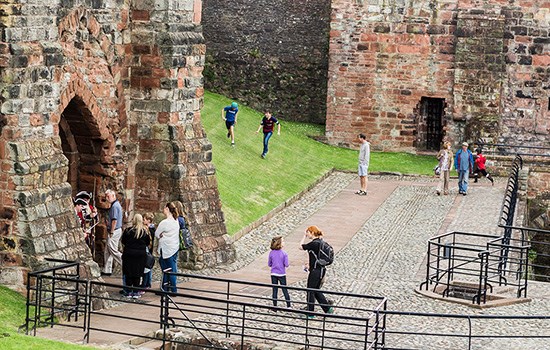
Plan your Visit to Carlisle Castle
Explore the medieval castle rooms, discover a turbulent history with the exhibition, and walk some of the castle walls.
-
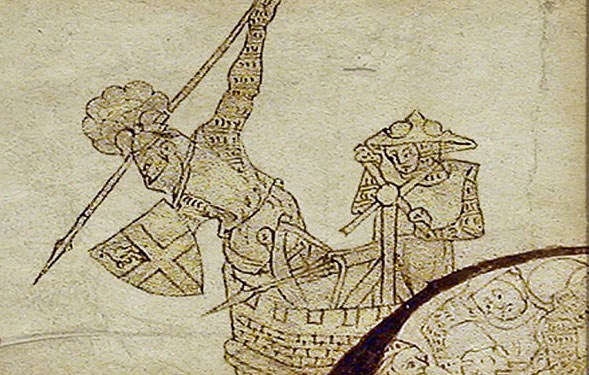
THE RISE AND FALL OF ANDREW HARCLAY
Learn how the Earl of Carlisle’s career, in which Carlisle Castle featured prominently, reflects both the rewards and the risks of engagement with Anglo-Scottish border politics.
-
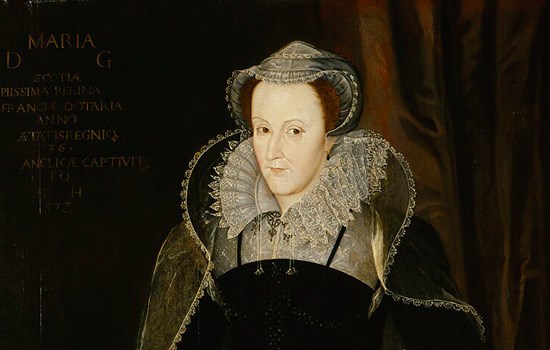
MARY QUEEN OF SCOTS
Find out more about Mary Queen of Scot's journey to England before her 19-year long imprisonment at Carlisle Castle.
-
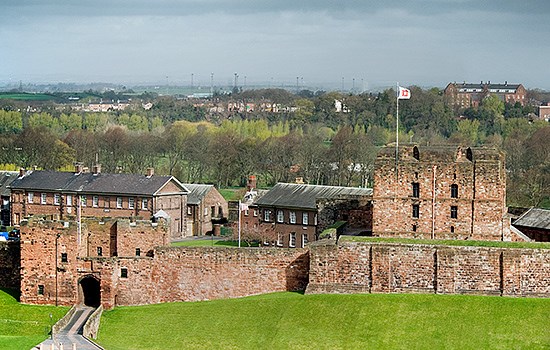
DESCRIPTION OF CARLISLE CASTLE
Read a description of the castle, whose grey and red sandstone buildings date from the 12th to the 19th centuries.
-
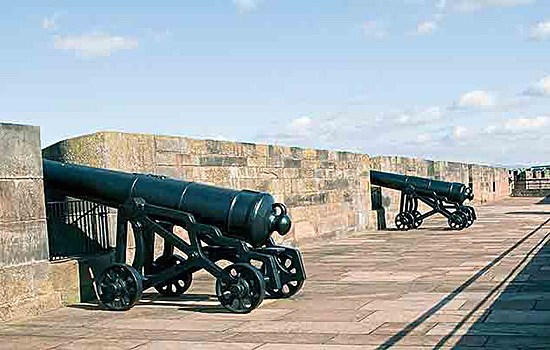
SIGNIFICANCE OF CARLISLE CASTLE
Since the 12th century Carlisle Castle has been in almost continuous military use. Learn about the castle’s long history of change and adaptation.
-
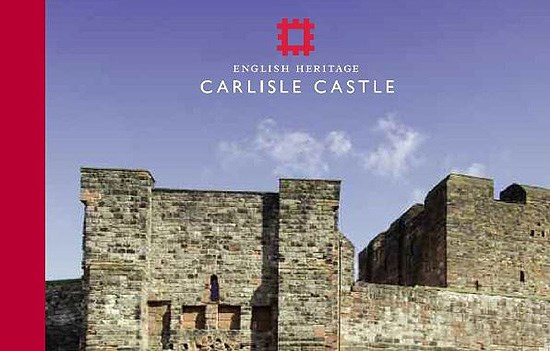
BUY THE GUIDEBOOK
The guidebook contains a beautifully illustrated tour and history, complete with colour photographs, plans, reconstruction drawings and eyewitness accounts.
-
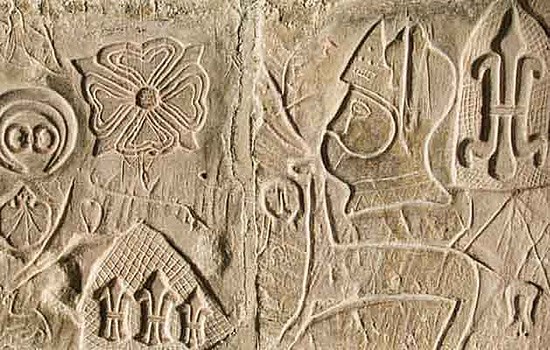
Research on Carlisle Castle
Carlisle Castle’s history and architecture are better understood than those of most medieval English castles. Read a summary of our research.
-
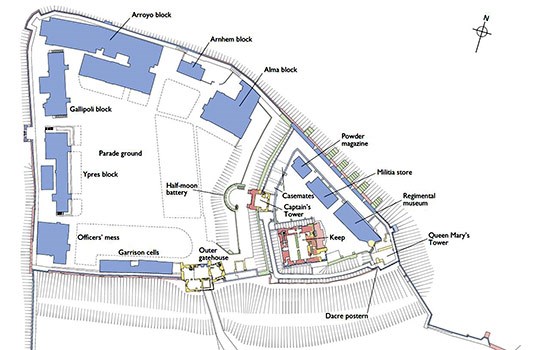
Download a Plan
Download this PDF plan of Carlisle Castle to explore the site, from the keep to the outer gatehouse and the Captain’s Tower.
Footnotes

